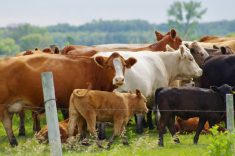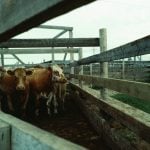Calves are born with a completely naive immune system. Unlike other species, cows don’t pass any immune protection onto their offspring during pregnancy. That’s why it’s so critical for calves to consume at least two litres of high-quality colostrum soon after birth, to give them some protection while their own immune system develops.
The calf’s developing immune system can learn to recognize and respond to disease-causing pathogens in two ways. It can learn the hard way — by being exposed to an infectious disease, surviving and responding more strongly the next time. But it’s better to learn in a safe environment. That’s what vaccines do — they teach the immune system to recognize what particular pathogens look like, so it can respond more quickly and effectively if those pathogens are ever encountered in real life. Like any other teaching exercise, repeating the lesson helps it to sink in and establish a stronger memory. Vaccines are the same, so revaccinating or boosting strengthens the immune memory.
A recent study (Vaccine use in Canadian cow-calf herds and opportunities for improvement; doi:10.3389/fvets.2023.1235942) found vaccination rates are on the rise. Over 85 per cent of producers in the Canadian Cow-Calf Surveillance Network routinely vaccinate nursing calves against bovine viral disease (BVD), and over 90 per cent vaccinate against infectious bovine rhinotracheitis (IBR), bovine respiratory syncytial virus (BRSV)and bovine parainfluenza-3 (PI3). That’s good news. But less than half of producers provided booster vaccinations against any of those viruses.
Read Also

Canadian Beef Check-Off Agency reports on investments and activities
The check-off agency’s work behind the scenes is what ensures cattle check-off dollars are invested wisely, accounted for transparently and deliver measurable value back to producers and importers.
Nilusha Malmuthuge (Agriculture and Agri-Food Canada Lethbridge) and Gleise Medeiros da Silva (University of Alberta) recently completed a proof-of-concept project to determine how vaccine handling practices — including providing a booster — affected their effectiveness in calves.
What they did: One hundred and fifty calves were vaccinated against PI3, BRSV, IBR and BVD types I and II using a commercial five-way modified live viral vaccine (e.g., Express FP5) at spring processing. The calves were divided into five experimental groups at weaning. The control group was not boosted. The other four groups were boosted with the same vaccine, but the vaccine was handled differently. One treatment kept the mixed vaccine in a cooler and administered it within an hour. A second treatment kept the mixed vaccine in a cooler but administered it six hours later. The third treatment left the mixed vaccine at room temperature and administered it within an hour. The fourth treatment left the mixed vaccine at room temperature for six hours before administering it.
Blood samples were collected before the booster vaccinations were given. A second sample was collected a month afterward. Serum antibody levels and virus neutralization tests were used to assess whether revaccination and vaccine handling affected the strength of the immune responses. They did not follow these calves to monitor whether they got sick or not. Doing that would have required thousands of calves and cost hundreds of thousands of dollars.
What they learned: It’s important to follow the label directions when using vaccines!
Boosting matters. The protection provided by the initial calfhood vaccine doesn’t last forever. A month after the booster vaccinations were given, all four groups of boosted calves displayed a stronger immune response than the unboosted calves. Those that weren’t boosted had lower immune responses than a month earlier. They would have had less protection against those viruses than the boosted calves.
Vaccine handling matters. Some vaccine antigens were less affected by storage temperature and mixing time than others, but vaccine handling methods clearly affected the animal’s ability to mount a strong immune response against BVD. Six to seven times as many animals failed to generate an immune response to BVD types one and two when mixed vaccines were kept at room temperature for six hours before they were administered compared to when the mixed vaccine was chilled and used within an hour.
Vaccines prepare calves for the germs they’ll encounter. The viruses in this vaccine are common in Canadian beef cattle. So, the calves would probably have been exposed and developed an immune response anyway, if they survived. But that’s the point. Vaccines allow the immune system to “practice” in a safe environment, without needing to expose them to the actual pathogen and risk death, illness and reduced growth performance.
Bottom line: Vaccines don’t eliminate disease. But when used properly, they reduce the number of calves that do get sick, and help ensure that those that do get sick, get less sick.
So what does this mean to you? If you aren’t vaccinating yet, start. Talk to your veterinarian about what diseases to vaccinate against; which vaccines to use; which animals to use them in; when to give them; how to store, mix, and administer them properly; and how to correctly calibrate, clean and maintain syringes.
Nearly all vaccines need to be given twice to provide maximum protection. Follow the label directions! If the label on the package insert is too small to read, a larger version can be printed from the Compendium of Veterinary Products. You can find it at the ‘Useful Links’ page at verifiedbeef.ca. Extensive vaccination resources are also available by searching for “vaccination of the beef herd” at beefresearch.ca.
The Beef Cattle Research Council is a not-for-profit industry organization funded by the Canadian Beef Cattle Check-Off. The BCRC partners with Agriculture and Agri-Food Canada, provincial beef industry groups and governments to advance research and technology transfer supporting the Canadian beef industry’s vision to be recognized as a preferred supplier of healthy, high-quality beef, cattle, and genetics. Learn more about the BCRC at beefresearch.ca.

















